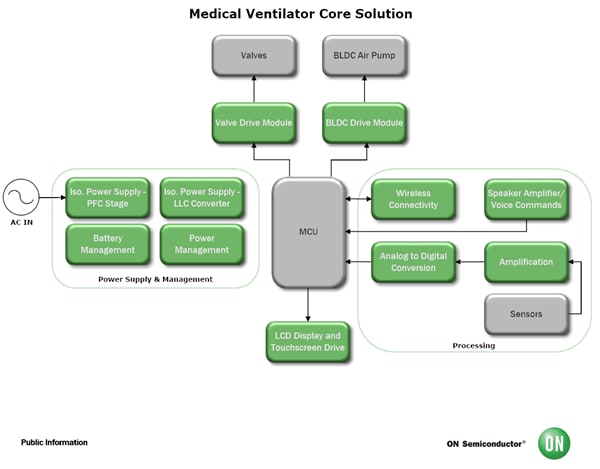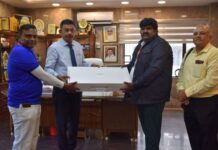As I write this, I’m working in my home office sequestered like most of the world’s population. I take this time to write while it is quiet, as quietness has quickly become a rarity in this household. My wife, Kathy, and I are babysitting our grandson, Charlie, while Charlie’s mom is deemed an essential worker as an Intensive Care Unit nurse at a local Arizona hospital. As we operate under a statewide “stay-at-home order” here, babysitting our grandson could, through a certain lens, appear like we are non-compliant to that order. Well, we’re not. Currently, she’s acting as a resource nurse with 31 COVID-19 patients, 11 of whom are relying on medical ventilators, a life-saving technology that is unfortunately under a global shortage during this pandemic.
The rapid increase in the number of COVID-19 hospitalizations has created an unprecedented strain on the world’s inventory of ventilators. ON Semiconductor and its operations have also been deemed as essential and critical infrastructure by the US Department of Homeland Security as a supplier of semiconductor components, which are a critical part of the supply chain for medical device manufacturers. ON Semiconductor’s products are used in various medical devices, including ventilators, which are helping keep COVID-19 patients with severe cases breathing. For those unfamiliar with a medical ventilator, ventilators move air in and out of the lungs in cases where patients are not physically able to breathe on their own and applications or use cases can be quite broad. Often, the machine forces humidified and warmed air with supplemental oxygen into the lungs. Equipment can be found in intensive care units, emergency rooms, ambulatory (meaning first-responder situations) and in the home.
Here, I explain ON Semiconductor’s Medical Ventilators Core Solution and its significance on life-saving medical technologies.
Components of a Medical Ventilator System
Complexity can differ greatly but common variables in a medical ventilator system are:
- The measurement of oxygen the ventilator is delivering during inspiration (or phase)
- Respiration rate per minute
- Tidal volume, which is the volume of each breath delivered
- Sensitivity, or how much inspiratory or trigger effort is required from the ventilator to recognize a patient’s attempt at inhalation. A trigger would prevent a ‘mechanical breath’, or a breath initiated by the ventilator
- Peak flow, or the flow of breaths
ON Semiconductor’s Medical Ventilator Solution
ON Semiconductor’s team of experts has worked diligently to provide a high-level system architecture for medical ventilators (Figure 1). Let’s dive into the many capabilities the components can offer these life-saving devices.

The architecture shown in Figure 1 is able to control one high-performance BLDC Air Pump (or more with the multiples of the same BLDC drivers), which is the “heart” of every medical ventilator. Each valve drive module implemented into the ventilator can drive up to six valves simultaneously.
For commonly used back-up batteries, ON Semiconductor’s NCP1871 keep every battery in a fully-charged state to be able to deliver the power when needed. As many manufacturers are using the multiple-battery setup, ON Semiconductor’s solution can be extended to as many hot-swappable batteries as the manufacturer implements by adding more battery controllers.
Further, ON Semiconductor offers several options including Bluetooth® Low Energy, Wi-Fi, and Sub-GHz radios for connecting to external data systems and hosts. Voice User Interface (VUI) is supported, as well as an alarm system for critical events with amplification for loudspeaker support.
Lastly, connectivity solutions also include multiple USB ports for connections to external drives, voice recognition hardware, internal display output with display drive, backlight drive and an HDMI output port that can be used to project the touch screen externally.
Many of the devices supported are automotive-qualified, a benefit that is becoming popular within the medical device manufacturing community. These automotive-rated devices usually offer more durability and extended working temperature ranges, making these features and capabilities attractive to the medical industry as well for diagnostic features and fault protection functions for safety.
Conclusion
ON Semiconductor, in collaboration with its customers and partners, plays a critical role in delivering life-saving medical technology. A team of experts developed ON Semiconductor’s Medical Ventilators Core Solution to be used in ICUs, emergency rooms, ambulatory services, and home healthcare for patients with severe breathing issues. The ON Semiconductor Medical Ventilators Core Solution features a BLDC air pump that can simultaneously drive up to six valves in a ventilator, ON Semiconductor Medical Ventilator Block Diagram to ensure the ventilator can deliver the power when needed, multiple connectivity options, a VUI, and an alarm system with amplification for loudspeaker support to alert medical staff of critical events. ON Semiconductor is proud to contribute to life-saving medical technology during this time and will continue to work diligently to make a difference across all industries.
The Semiconductor Components for Medical Ventilators blog was written by Steven Dean and was first published on onsemi.com.

Steven Dean has over 25 years of experience in the semiconductor and medical device fields, now leading ON Semiconductor in Business Marketing in their Signal Processing, Wireless, and Medical Division. Past appointments have included, Director of Business Development at Medtronic Corporation, Director of Marketing at Texas Instruments, and Director of Segment Marketing of Freescale Semiconductor. Steven obtained his degree in Electrical Engineering from Purdue University, with postgraduate work in Business. Steve’s leisure pursuits include spending time with his wife Kathy and now three grown children, sailing in the tropics, brewing beer, and wrenching on one of his classic automobiles.














